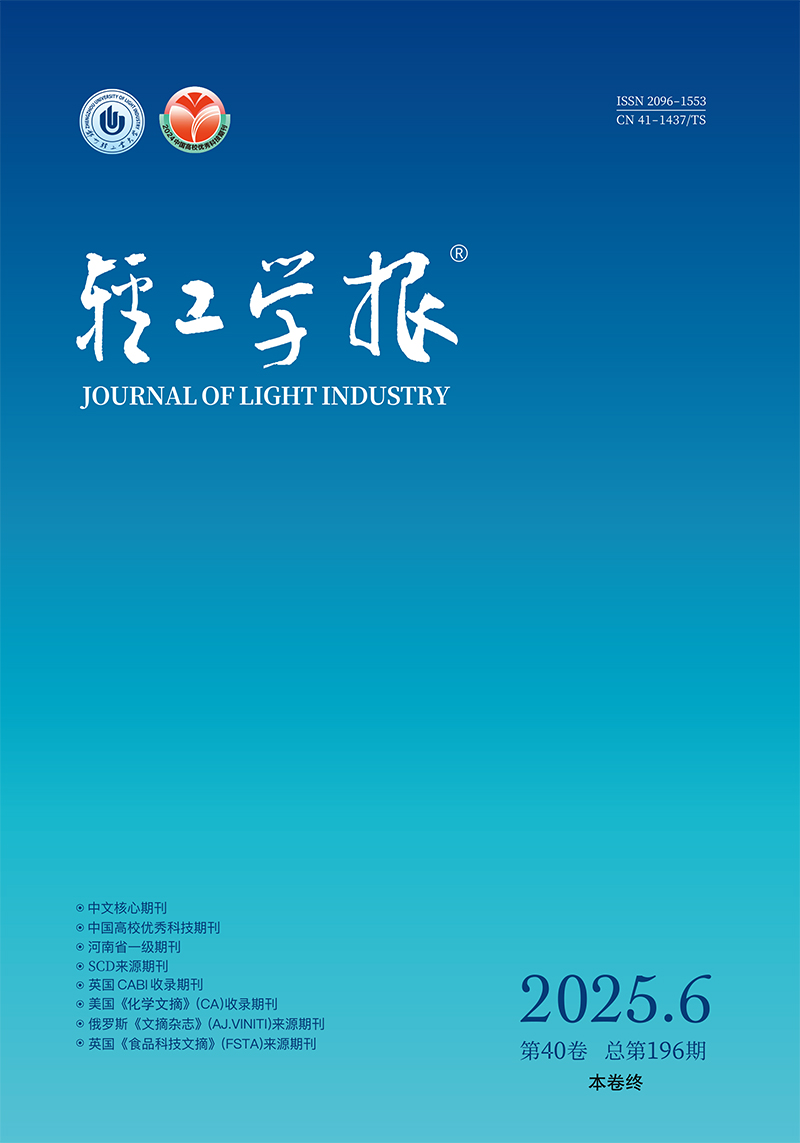2018 Vol. 33, No. 6
Display Method: |
EDTA-chitosan was prepared through the acylation modification between EDTA-2Na and chitosan. The preparation conditions of EDTA-chitosan were optimized by single factor test combined with orthogonal optimization test. The comparative analysis of Cd2+ adsorption properties of EDTA-chitosan was made with that of chitosan hydrochloride, chitosan quaternary ammonium salt, hydroxypropyl chitosan and chitosan lactate. The results showed that the optimum preparation conditions of EDTA-chitosan were as follows:the mass ratio of EDTA-2Na and CTS was 2:1, the pH value was 5.5, the concentration of EDAC was 40 mmol/L, and the reaction time was 16 h. The verification experiment under these conditions showed that the average Cd2+ adsorption rate of EDTA-chitosan was 53.04%. Moreover, the comparative experiment revealed that EDTA-chitosan had better Cd2+ adsorption effect than other chitosan derivatives under the same conditions.
Using chitosan as raw material, liquid paraffin as dispersant, formaldehyde as pre-crosslinking agent and epichlorohydrin as crosslinking agent, crosslinked chitosan microspheres were prepared by reversed-phase suspension method. The adsorption properties of crosslinked chitosan microspheres on aromatics carboxy compounds in water were studied. The results showed that it had fast adsorption rate and large adsorption capacity,the saturated adsorption capacity of crosslinked chitosan microspheres for 2-hydroxy-3-naphthoic acid, α-naphthoic acid and benzoic acid were 702.0 mg·g-1, 320.1 mg·g-1, 176.3 mg·g-1 at the pH value of 3.5 and 288 K, respectively. The adsorption process conformed to the Lagergren-second-order kinetic equation, and the adsorption isotherm model conformed to the Langmuir isotherm adsorption equation, which was mainly monolayer adsorption. The adsorption process was a spontaneous, exothermic and entropic reduction process with physical adsorption and chemical action. The crosslinked chitosan microspheres had good recycling ability. After 8 cycles of regeneration, the adsorption capacity could still be stabilized above 97%.
BPA simulated wastewater was treated by Sequencing Batch Bioreactor (SBR) to investigate the effects of different BPA wastewater treatment methods on sludge acute toxicity and protein expression. The results showed that when the influent BPA concentration was 40 mg/L, the sludge activity in the BPA-impacted SBR was significantly inhibited, and the mass concentration of the effluent COD was significantly higher than that of the SBR gradually acclimated by the influent BPA.With the extension of running time, the mass concentration of BPA in the aqueous phase and mud phase increased first and then decreased until it was completely degraded. In the whole SBR operation, sludge and EPS acute toxicity in the SBR impacted by the BPA were both higher than that of the gradually acclimated SBR, but EPS acute toxicity had little effect on the acute toxicity of sludge;The protein expression in the sludge treated with different methods of BPA wastewater showed significant differences. The concentration of BPA and the way of degrading BPA had a significant effect on the protein expression in the sludge.
Three kinds of aquatic plants, such as eichhornia crassipes, water hibiscus and commom duckweeds were used as water purification materials, and the purification effect of aquatic plants was studied with the treatment of water in university A in Zhengzhou.The results showed that the purification effects of three aquatic plants on COD in water were followed by eichhornia crassipes > water hibiscus > commom duckweeds; the purification effect of ammonia nitrogen was in the order of eichhornia crassipes > commom duckweeds > water hibiscus;the purification effect of total phosphorus was in the order of water hibiscus> eichhornia crassipes> commom duckweeds.There was no obvious rule to the effect of pH value in water.Comprehensive comparison showed that eichhornia crassipes had a better purification effect on the synergistic removal of multiple pollutants in the landscape water.
The GO/WO3/PANI ternary composites were prepared by hydrothermal synthesis and in situ polymerization using sodium tungstate as the main raw material. The electrochemical properties were tested. The results showed that the composite of ternary materials could improve the overall electrochemical performance of the material. At the scanning rate of 20 mv/s, the addition of nano-WO3 was 0.42 g, and the electrochemical performance of ternary composites sample GWP-4 was the best; as the charge and discharge current increased, the discharge time of the sample was shortened, and the specific capacitance was reduced. When the charge and discharge current was 0.2 A/g, the specific capacitance was the largest, which was 107 F/g.
The research status of the improvement of the mechanical properties and the functionalization of gelatin-based hydrogels from the cross-linking modification of gelatin, blending with other polymers (including interpenetrating network and dual network), and recombination with nanomaterials was reviewed. It was pointed out that the chemical cross-linking modification of gelatin was more widely used than physical cross-linking modification, but the excessive amount of chemical cross-linking agent would produce certain toxicity; the interpenetrating network could combine gelatin with other polymer networks. The nature of the dual network topology could greatly improve the mechanical properties of gelatin-based composite hydrogels; the introduction of different nanoparticles or nanoparticles with special functions into the gelatin system could avoid the toxicity of traditional chemical crosslinkers. Functionalized gelatin based nanocomposite hydrogel with high tensile strength was obtained. Further optimization and design of gelatin-based hydrogel materials with mechanical strength, biocompatibility and tissue adhesion suitable for biological tissues to improve their mechanical properties and stimuli in complex environments will be the future research direction.
Health wine was prepared from six Chinese medicines, such as ginseng etc..The active ingredients were extracted by Soxhlet extraction and then decolorized by decolorants. The concentration of Ginsenoside and absorbance at 560 nm in health liquor were set as the extraction and decolorization index, respectively. The uniform test on the basis of single factor test was conducted to optimize the extraction and decolorization process. The results showed that the highest extraction rate of ginsenosides was 67.63 mg/(100 mL) when the reaction temperature was 97℃, the reaction time was 2 h and the liquid-to-material ratio was 610:1. Moreover, when the decolorization temperature was 35℃, the decolorization time was 20 min, the liquid-to-material ratio was 5:1 and the decolorizing agent was activated carbon powder, the deodorization effect was the best, and the liquor color was appropriate. Under this condition, the loss rate of glycosides was only 2.47%.
The quinoa flour was added into wheat flour at different proportions (0~30%), and the effect of quinoa flour addition on the farinograph and extensograph properties of dough, as well as the specific volume and diameter height ratio of steamed bread was tested. Texture characteristic test and quality evaluation of steamed bread were made. The results showed that with the addition of quinoa flour in wheat flour exerted significant effect on the farinograph and extensograph properties of dough(p<0.05). When the addition of quinoa flour reached 5%~15%, the specific volume and diameter height ratio of steamed bread were significantly increased. Moreover, the springiness, chewiness, appearance colour and taste of steamed bread were improved greatly.
Two hydrophobin genes, Po.hyd1 of Pleurotus ostreatus and Le.hyd of Lentinula edodes were ligated to construct the expression vector pPIC9k-Po.hyd1-Le.hyd, and then it was transferred into the Pichia pastoris GS115 competent cells by electroporation. After PCR validation and geneticin G418 resistance screening, three highly expressed Pichia pastoris transformants were obtained. After separation and purification of fusion hydrophobin Po.hyd1-Le.hyd from fermentation supernatant by the trifluoroacetic acid method, it showed that its monomer was about 26 kD. The fermentation conditions of P. pastoris were optimized by single factor and response surface analysis and the best fermentation conditions were showed as followed:the mass fraction of carbon source (methanol) was 0.62%, the mass concentration of nitrogen source (m (yeast extract):m (peptone)=1:2) was 8.39 g/L, the initial pH value of the fermentation medium was 6.05, the mass concentration of YNB was 100 mg/L, the fluid amount was 50 mL and the initial OD600 value was 1.2.Under the above conditions, the maximum yield of the fusion hydrophobin Po.hyd1-Le.hyd could be up to 30 mg/L. The foaming and emulsifying properties of the fusion hydrophobin Po.hyd1-Le.hyd were investigated and they were all better than that of fusion hydrophobin extracted from the Pleurotus ostreatus mycelium.
Aiming at the problems of low accuracy,long detection time and poor reliability of existing insulation detection system for electric vehicles,on the basis of studying the inherent mechanism of the measurement accuracy and reliability of insulation resistance for electric vehicles,replacing traditional electric relay by resistance partial measurement and optical control relay,an insulation resistance detection circuit of unbalanced bridge based on high-precision instrument amplifier was designed,then a four-step on-line calculation method of insulation resistance was proposed. Finally,a number of insulation resistance tests were completed for a light truck. The results showed that the detection system could achieve 5% insulation resistance measurement accuracy,and had the advantages of on-line detection and high reliability.
In the existing prediction model of ammonia nitrogen in sewage treatment effluent, the hidden layer neurons excessively redundant, which wastes resources. A new structure adjustment algorithm (HCPS) based on sensitivity analysis (SA) and mutual information (MI) was proposed. The algorithm redefined the sensitivity formula, adaptively, adjusted the network structure by using sensitivity and mutual information, deleted hidden neurons with low sensitivity, divided hidden neurons with excessive sensitivity, and merged two hidden neurons with excessive mutual information. The results of verification on BSM1, a benchmark simulation platform for sewage treatment, showed that HCPS algorithm could obtain a more compact network structure, and the prediction accuracy of ammonia nitrogen concentration in effluent was higher.
Aiming at the problem that the traditional thermal network model is not suitable for IGBT short-circuit junction temperature measurement, based on the analysis of the failure mechanism of IGBT in the case of transient short-circuit, the energy value of IGBT short-circuit failure was defined.The evolution law of the critical energy value of IGBT under different initial temperature and different bus voltage was found, and finite element thermoelectric coupling model was established. The simulation results showed that with the increase of DC bus voltage, initial temperature and current density, the short-circuit maintenance time and critical energy value of IGBT would be greatly reduced while the critical temperature point of IGBT failure was independent of the initial temperature; the heat transfer before IGBT failure only reached the solder layer during the short-circuit process, and the maximum temperature point of IGBT was distributed at the boundary of the depleted layer at the instant of short-circuit.

Founded in 1986, bimonthly
Administered by:The Education Department Henan Province
Sponsored by:Zhengzhou University of Light Industry
Editor-in-chief:Wei Shizhong
Executive Editor-in-Chief:Zou Lin
Deputy Editor-in-Chief:Qu Shuanghong
Edited & published by:Editorial Department of Journal of Light Industry
CN 41-1437/TS
ISSN 2096-1553
Address:136 Science Avenue, Zhengzhou City, Henan Province, China
Postal Code:450001
Tel:(086)0371-86608635
(086)0371-86608633








